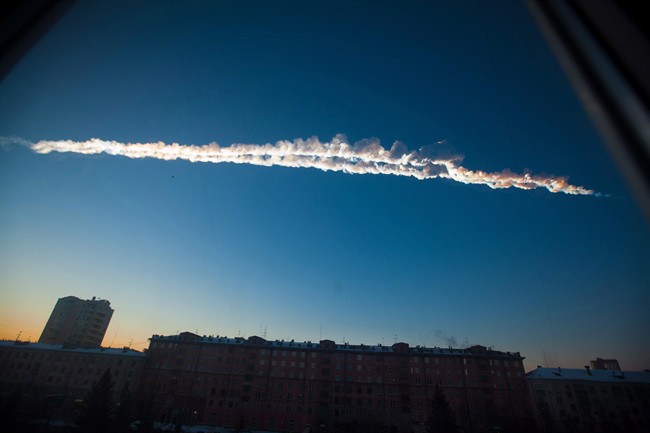TORONTO – Every year there are plenty of science stories to satisfy the curious.

Well, 2013 was no different. Here are a few stories that may have had you on the edge of your seat.
Chelyabinsk meteor
Like something out of a science fiction movie, the early morning sky was set ablaze in Chelyabinsk, Russia, on the morning of Feb. 15.
A fireball was captured on numerous dashboard cameras, traffic cameras, and security cameras around the area, making it the most well-documented meteor in history.
The space rock was estimated to be 17 metres in diameter and weighed about 10,000 tonnes before it entered our atmosphere at 65,000 km/h. About 500 kilotons of energy was released.
As the rock pushed the air in front of it, it exploded about 23 km above the atmosphere. More than 1,000 people were injured as the blast shattered windows.
Months later, NASA research found that the plume of debris from the meteor blast in the atmosphere circled the globe in just four days.
A part of the meteorite (once it reaches the ground, it’s called a meteorite and not a meteor) was recovered from a Russian lake in October.
Chris Hadfield
Chris Hadfield not only changed how we viewed life in space, but he also helped us see the beauty of our own planet.
Hadfield, a native of Sarnia, Ont., was launched into space on Dec. 19, 2012.
Once there, he used social media — most notably Twitter — to send breathtaking views of Earth. He also sought to answer many questions about life in space, like how to make a sandwich and shave.
READ MORE: Global’s Dawna Friesen: One-on-one with Cmdr. Chris Hadfield
Hadfield breathed new life into space and space science, gaining more than a million followers on Twitter.
- As Canada eyes AI growth, could electricity demands fuel climate change?
- ‘Significant risk’: How will wildfires spread over the next two months?
- London Drugs issues apology, says no evidence of compromised data in cyberattack
- B.C. fruit likely to be in short supply and expensive this year: produce retailers
Hadfield returned to Earth May 13.
Voyager edge of solar system
Goodbye solar system, hello interstellar space.
On Sept. 12, NASA confirmed that Voyager 1 had left the bubble of our solar system and had reached interstellar space, making it the first human-made spacecraft to have accomplished that. A monumental task, for certain.
Voyager 1 and 2 were launched to study the outer planets of our solar system in 1979.
Voyager 1 was roughly 19 billion kilometres from the Sun when it left our solar system.
Giant serpent-like oarfish
On Oct. 13, a marine science instructor was snorkelling off the Southern California coast when she spotted the carcass of an 8-foot-long, serpent-like oarfish. It took her and 15 others to drag it to the shore.
Oarfish dive more than 900 metres deep, making sightings of these odd-looking creatures rare.
Oarfish can grow to more than 15 metres and are the longest bony fish in the world.
Comet ISON
It was the comet that was to light up our pre-dawn skies.
Comet ISON was discovered by two Russian astronomers in September 2012.
It was hoped that the comet, once it swung around the sun, would put on a dazzling display in the sky in December, so all eyes were on the comet on Nov. 28 as it made its closest approach to the sun. However, it was not to be.
Unfortunately, Comet ISON was vaporized as it approached the sun. There were a few moments of hope as something re-emerged after the comet swung around the sun, but, it was merely a ghost of what the comet once was.
READ MORE: Comet ISON a dud? Not for one scientist
Though it may seem like the ISON was a big letdown, scientists will tell you otherwise. They will be continuing their analysis of the comet for months to come.




Comments